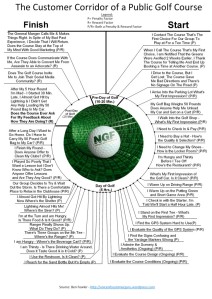My last blog post discussed the failures of Sony and McCulloch in assuming that they understood the needs of their customers instead of actually knowing. You know what the old saying is when you assume. The penalty for assuming the needs of their customers for McCulloch and Sony was steep, to the tune of billions in lost profits. In the case of McCulloch, this mistake ultimately led to the undoing of the company, as they went into bankruptcy in 1999.
Sony executives made what they believed to be a correct assumption that picture quality was the crucial need that a customer would consider when purchasing a personal video recorder. Yet, the Beta Max became extinct. Why? Sony didn’t fully understand the needs of the customer and which needs would be greater drivers in the final decision-making process of the recorder that the customer would buy.
Many operators may make the assumption that good greens is all they need at their course. While good greens are important, I have identified 38 separate touch points that can affect the experience of a customer at a public course. Not all customer touch points are equal. Based on research published by Professor Noriaki Kano, I have classified touch points into the following groups; penalty, reward or a combo of penalty & reward factors. For example, one of the touch points that I mapped out is the sand bottle on a golf car. The customer expects it to be full, and when a course meets this expectation by providing a golf car with full sand bottles the course won’t realize any additional reward in terms of customer loyalty, it’s expected! But if the customer reaches for the sand bottle and they are empty, customer loyalty likely will take a hit. Put another way, in my book an empty sand bottle on a golf car equals strike one. That’s not to say that this mistake can’t be overcome. If my experience is great at every other touch point, I’ll probably forget about the sand bottle. But if I am left unfulfilled at the other touch points, that empty sand bottle will be just one piece of ammunition in my rifle when I take aim and fire at the course through my negative referrals to friends. Failed touch points like these, make up the fertile breeding ground of irate assassins. When the course provides the customer with the ammunition of unfulfilled expectations on key touch points, assassins will be determined to complete their hit by launching an all out assault on the business that failed them.
A key tool that can help companies understand the needs of the customer is a “Customer Corridor Map.” I hope to help public golf course operators rethink the needs of their customers by mapping out the customer corridor for a round of golf. The goal of this map is to help courses shift their focus on customer needs from an inside-out approach to an outside-in approach.
Bottom Line: An outside-in approach to the needs of your customer will allow you to better understand your customer touch points and maximize the customer experience!
